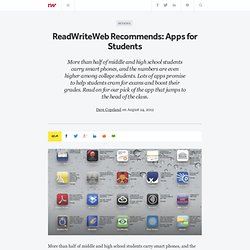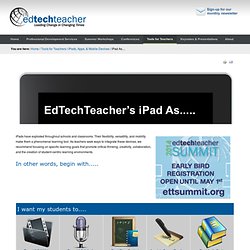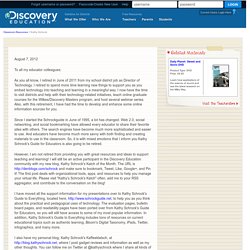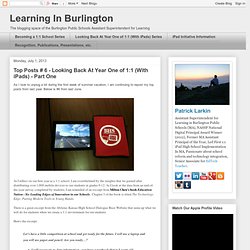

21C Learning. EES. Learning Analytics. 10 Must-Have Free Back To School Apps. Many students, teachers, and staff are all going to be headed back to school this year with something new: new technology.

Whether it’s a laptop, desktop, or mobile device… there’s going to be a big surge in demand for educational apps. Let Edudemic be your trusty guide and check out the following list of helpful educational apps that are perfect for your classroom (whether you’re a teacher or student). What’s Your Favorite? Get It Free! As you can imagine, there are many more apps that are handy to have so be sure to share your favorite(s) with Edudemic by writing them on the Edudemic Facebook page . 1. Wunderlist makes it downright simple to organize your daily life. Don’t like working alone? No matter where you are or what you’re doing, your organization can finally come along! 2. Evernote makes it easy to remember things big and small from your notable life using your computer, phone, and the web.
Keep a notebook of all your recipes and tag them by cuisine or ingredient. But wait! 10 Things Students Won’t Need To Know When They Graduate. Most of the students that we work with are between seven and twelve years from walking across the stage to receive their diploma from high school. A generation ago, change often took a decade, and trends in music, fashion, and politics all phased in and out in these generous chunks of time, but the tempo of life has changed as technological advances have accelerated life to a point when decades worth of changes are now being compressed into a year or less. This creates unique challenges for today’s school leaders as we try to wrestle our curricula into a shape that can meet the needs of individual children while being vibrant enough so the curricula don’t become an outdated document over the course of a year.
Here are some ideas about the next decade that may help leaders as they make future decisions about curriculum, instruction and assessment. Below are some of the terms, phrases, concepts, and skills that many of us teach today with no future except their links to the past. 10. 9. 8. The 4 Big Reasons You Should Try Mobile Learning. The idea of implementing mobile learning into a course or instruction may be daunting for many educators. They may assume that mobile learning (aka m-learning) is too complicated and so decide to stick to the methods they have more experience with.
Besides, the old fashioned methods of learning have worked for centuries, so what’s the need for change? The Teacher’s Quick Guide To Education Technology. How Online Education Has Changed In 10 Years 8.56K Views 0 Likes We all know that education, specifically online education, has come a long way in the last few years. We've already taken a look back - way back - at online education as we rarely think of it (in the 1960's and 70's), but it is also interesting to see just how much online education has evolved in just the more recent past. 5 Reasons We Use Social Media 9.95K Views 0 Likes.
Why Students Like Social Media But Schools Don’t. Social media is here to stay. Students love it. Teachers love it. Picture 418 « 20 Classrooms From Around The World. Is This Now A Typical Classroom? 11.28K Views 0 Likes When you imagine a 'typical classroom' - what do you picture? If it's a boatload of laptops facing you with students hiding behind the screens, you're not far off. Why America’s Top Colleges Offer Free Classes Online. Elite universities are throwing open their classrooms’ doors to anyone with an Internet connection—for free. Why are colleges offering free classes? They don’t want to be left behind in the digital revolution that has already transformed the way we consume news, music, and books.
Stanford, Duke, Princeton, and Johns Hopkins are among the 16 universities that have partnered with a newly launched company called Coursera to offer more than 100 free online courses this academic year; MIT, Harvard, and the University of California, Berkeley, are following suit through a nonprofit venture called edX. Now people anywhere in the world can take Stanford’s “Introduction to Mathematical Thinking,” learn the “Principles of Obesity Economics” at Johns Hopkins, or have Duke University behavioral economist Dan Ariely lead them through “A Beginner’s Guide to Irrational Behavior”—all without paying the $50,000 usually required to attend these world-class universities. How The New Learnist Apps Signal A Change In Education Technology. If you haven’t heard of Learnist yet, you’re going to see the name around a whole lot more as of 11am today. That’s because Learnist just launched its new iPad and iPhone apps . Edudemic got a hands-on view of these apps and they are quite remarkable.
Not just because they’re fancy apps that look nice, but because of what they signal to the larger world of education technology. Board resumes effort to fire Lynden Dorval for ignoring no-zero policy. Lynden Dorval, Edmonton’s Mr.

Zero, gets a lesson in school conduct When students, as they sometimes do, decide they don’t like a school policy and make a show of defiance — showing up in the T-shirt they were told to leave at home, or with the pink punk haircut that violates the dress code — my general reaction is that they should quit making a spectacle of themselves and do what they’re told.
Understanding Learning Analytics and Student Data. Five Ways to Bring Innovation Into the Classroom. 3 Back-to-School Tips for the Tech-Savvy Professor. If you are looking for some free and easy ways to engage with your students this fall, we have a few ideas that are guaranteed to help.

Technology should never get in the way of your teaching, but, if used properly, it can be extremely helpful to you and your students. By leveraging a few free services on the Web, you’ll have the opportunity to communicate with your students and connect with other professors using new technology. Cheating Like Weasels in Online Classes. An article in the Chronicle of Higher Education about ignited a fireball of blogging last week about how online learning will, once again, be the ruination of all higher education.
The Chronicle article focused on anecdotal evidence that students enrolled in free massive online courses (MOOCs) are plagiarizing their essays in literature courses. So what’s the problem with online learning this time? It lacks credibility because it encourages people to cheat. Why Are Textbooks So Expensive? The beginning of a freshman’s college experience is an exciting time. Recommends: Apps for Students. More than half of middle and high school students carry smart phones, and the numbers are even higher among college students.

Lots of apps promise to help students cram for exams and boost their grades. Read on for our pick of the app that jumps to the head of the class. We dove into study apps and found that most are not free, but price isn't always equal to usefulness. The ones we reviewed averaged about $5, but we ran across one that was $30. Sadly, too many were nothing more than scheduling, organizing and prioritizing apps, with little or no thought about the unique demands that students face.
5 Things Every Presenter Should Know About People, Animated. Making-case-for-mobile-learning. 29-ipad-resources-tutorials-and-guides. iPad As.... iPads have exploded throughout schools and classrooms.

Their flexibility, versatility, and mobility make them a phenomenal learning tool. As teachers seek ways to integrate these devices, we recommend focusing on specific learning goals that promote critical-thinking, creativity, collaboration, and the creation of student-centric learning environments. In other words, begin with..... 25 Ways Teachers Can Integrate Social Media Into Education. Internet giants suddenly vulnerable in mobile land grab. Teaching and Learning through Design Thinking - EdTech Researcher.
Last week was a big week for design thinking in education, both in the field and for me personally.

In the wider world, Edutopia is hosting a free course on Design Thinking for Educators which launched last week and continues this week. For me, I facilitated a "Design Charrette" learning group at Project Zero's Future of Learning Institute. The Future of Learning Institute is a professional program run by the Harvard Graduate School of Education. It's a combination of plenary lectures, break-out group workshops, and then learning groups designed which are designed to foster discussion and reflection to synthesize learning. My concern with these kinds of professional development models, with lectures and break out groups, is that the don't always provide a space for educators to experience innovative learning environments. In our design process, we had participants first learn to think like an artist.
Tech Tools / 9 EXCELLENT NEW WEB TOOLS TO TRY @grade56j @MrsMartel2 @kmcevoy50 @llangsford @suedaun @MrCorcoranBlog #ocsb. Crowd Sourced Advice for New Teachers. High School Students Want More Tech, Fewer Lectures - Digital Education. iPads in Education- Examples from the Classroom. 10 Ways Twitter Has Made Better Teachers. Build iPhone and Android apps or HTML5 mobile web app online.
Ant's ICT. By far the highlight for many of us at the NAACE Hot House event earlier this week was the presentation by Torsten Stauch from Appshed.com.

Torsten put a good deal of effort into his presentation and made every attempt to show linkage between his online tool for making free web apps and the new NAACE Framework. Though his talk was interesting and a good attempt at linking curricula with product, it was the tool itself that excited us. Welcome to Discovery Education. Home Page. August 7, 2012 To all my educator colleagues: As you all know, I retired in June of 2011 from my school district job as Director of Technology.

Home Page. August 7, 2012.

Teacher-Retention Tip: Lose the 'Martyr Mentality' - Teaching Now. 7 Excellent Tools to Publish Students Work. 5 Timeless Commencement Addresses. Can Social Learning Through Social Media Boost Employability? Design Thinking Workshop for Educators: Applying Creative Problem Solving to Classrooms. The Top 10 Education APIs (And Why They’re Important) First off, what is an API? The Best Resources For Beginning iPad Users. Looking Back At Year One of 1:1 (With iPads) - Part One. As I look to unplug a bit during the first week of summer vacation, I am continuing to repost my top posts from last year.

Convert to Cartoon — Convert photo to Cartoon — Cartoonize Yourself. 10 Great Flashcard Making Tools for Educators. 1- FauxFlash FauxFlash is a great online application that takes the hassle out of flash cards and lets you easily get right to studying. Portfolio Development for Early Childhood Educators. Teachers Easy Guide to The Most Important Web Tools in Education. Digital Literacy - Assessment Instructions. A Teacher’s Guide to Social Media. How to recognize true learning. Infographics / The Must-Have EdTech Cheat Sheet!
4 Lessons In Creativity From John Cleese. Digital Immigrants & Natives. Part Three: Ten Steps… Transforming Past Lessons For the 21st Century Digital Classroom. 20 Things New Teachers Need to Know. [Infographic] Components of a 21st Century Classroom. 10 Interactive Lessons By Google On Digital Citizenship. The 2012 ADE Institute. Fast Tracking a Ph.D. 181 Google Tricks That Will Save You Time. Web 2.0 Social Networking Tools: A Quick Guide.
iPads in Education- Examples from the Classroom. Scoop.it. Doing The Impossible: Helpful Tool Lets You Track And Assess Mobile Learning. The Educator's PLN - The personal learning network for educators. Centre for Learning & Performance Technologies. eAssessment. Part One: Ten Steps… Transforming Past Lessons For the 21st Century Digital Classroom. Part Two: Ten Steps… Transforming Past Lessons For the 21st Century Digital Classroom. 12 Tools for Quickly Gathering Informal Feedback from Students. Nine Survey Tools for Teachers and Students. Three Free Tools for Creating infographics. What Works in Student Learning, and What Gets in the Way – Teaching – The Chronicle of Higher Education — Tennessee Teaching and Learning Center.
Learn It In 5 - Home. Bring Your Own Device - Apps & more. Mobile-formative-assessment-one-device. Standing Committee on Finance and Economic Affairs - - Pre-budget consultations. The Design Cycle in Humanities Class. Thumb.it Review - Real Time Opinion Platform. 5 Reasons Tablets Will Change Higher Education in the Next 5 Years. 46% Hold Creationist View of Human Origins. A Thumbs up to Thumb.it from The Digital Media Strategist.
MKT 337 Principles of Marketing GOLDEN. A Note on Distance Education in Principle of Marketing for Non Marketing Majors. 25 Ways To Use iPads In The Classroom by Degree of Difficulty. Innovation%20Report%202012. Q&A: Pearson CEO Addresses Digital Content Issues - Marketplace K-12. Future Impact of Technology on Teaching and Learning - The UK Higher Education Blog.
Complexity2. The Value of Teaching and Learning Technology: Beyond ROI. Education vs Employment (Infographic) Uscs-degree-salary-unemployment.png 1,284×1,139 pixels. The Future Trends of the Job Market. The Best Resources For Showing Students Why They Should Continue Their Academic Career. Why Flipped Classrooms Are Here to Stay. The Next Big Disruptor – Competency-based Learning? Hardware and Software Trends. How BYOD Fits Into The Insanely Crowded World Of Education Technology.